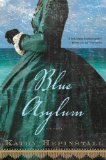Summary | Excerpt | Reviews | Beyond the book | Read-Alikes | Genres & Themes | Author Bio

A Novel
by Anna HopeSet in 1911 and inspired by the revelation that her great-great-grandfather had been committed to an asylum, where he eventually passed away, Anna Hope imagines a story of two patients whose paths cross at an asylum she names Sharston. The Ballroom illustrates the ease with which one might have been committed in that era and the risks of such an experience.
The novel is told from the points of view of three characters. Two are patients: illiterate factory worker Ella Fay and travelling Irishman John Mulligan, whose attraction to each other blossoms at the weekly dance in the ballroom, the only time the sexes mingle. The third character, Doctor Charles Fuller, harbors ambitions to contribute to the eugenics movement – controversial ideas to improve the human gene pool – (see Beyond the Book) and he is preparing a paper to present at the first international eugenics conference.
All three voices create an intimate insight into the minds of their characters, leaving the reader wondering who truly is sane and who is not, because in borderline cases like Ella and John's, committed for reasons that would never be considered valid today, the definition of sanity is a matter of perspective of those in power – meaning husbands, fathers or employers.
The novel begins with the incarceration of Ella, admitted to the asylum by her employer for smashing a window in the factory she had worked in since she was a child. She had only wanted to see the sky. Hope depicts the feeling of claustrophobia that had begun to overwhelm Ella as her concentration wavered and sleep threatened to engulf her in the dark, stuffy, noisy factory: "And the noise. She sometimes thought that was what the place made: noise and cloth, but mostly noise; so much it drowned your thoughts, so much you heard it ringing and buzzing in your ears all the way through your day off."
John is in the asylum because he is depressed – grieving the loss of a wife and child, and unable to imagine how he might ever feel love in that way again. Doctor Fuller is out to prove something, having failed to live up to his father's expectations, only now it isn't him he is trying to impress, it is the man who has the ear of Home Secretary Winston Churchill, a firm supporter of the eugenics movement. Passionate about music, Doctor Fuller plays the violin and organizes the orchestra for the weekly Friday evening dance, an event for which patients eagerly await, and an activity he believes vital to the improvement of their health. But when he loses sight of objectivity, and begins to display his own symptoms of a disturbed mind, the people around him – his patients – begin to suffer.
Hope illustrates the blurred line between perceptions of madness, as those in charge appear as susceptible to the degradation of mind as those committed; as authority fuels ambition and the powerful seek to dominate and neutralize the weak. Through Fuller's experiments and research, she explores the ambitions and arguments for and against the eugenics movement, exposing the thinking of British scientists and government at the turn of the 20th century, and the dangers of becoming a target of those who strove to improve humanity through the modification or elimination of those they perceived as being less than desirable.
Hope's genuine compassion for those committed is evoked in the specific language and style she adopts, through letters that pass between the patients, as well as their appreciation of the little they see of the outdoors, deprived as they are of nature the great healer. "Dan says he can speak with trees. But they take a while to answer. That's why you have to learn to listen. If we listened he says we could not cut down our friends."
A haunting, highly readable novel of extremes, The Ballroom explores love and loss; progress and terror; and nature versus the institution, all of which will appeal to those who enjoy books with a slow tension-fueled build-up and an emotionally satisfying ending.
![]() This review
first ran in the October 19, 2016
issue of BookBrowse Recommends.
This review
first ran in the October 19, 2016
issue of BookBrowse Recommends.

If you liked The Ballroom, try these:

by Serena Burdick
Published 2020
A beautiful tale of hope, courage and sisterhood, inspired by the real House of Mercy and the girls confined there for daring to break the rules.

by Kathy Hepinstall
Published 2013
In the midst of the American Civil War, a southern plantation owner's wife is arrested by her husband and declared insane for interfering with his slaves. She is sent to an island mental asylum to come to terms with her wrongdoing, but instead finds love and escape with a war-haunted Confederate soldier.
Your guide toexceptional books
BookBrowse seeks out and recommends the best in contemporary fiction and nonfiction—books that not only engage and entertain but also deepen our understanding of ourselves and the world around us.